What is the origin of the word “mainframe”, referring to a large, complex computer?
Most sources agree that the term is related to the frames that held early computers, but the details are vague.1
It turns out that the history is more interesting and complicated than you’d expect.
Based on my research, the earliest computer to use the term “main frame” was the IBM 701 computer (1952), which consisted of boxes called “frames.”
The 701 system consisted of two power frames, a power distribution frame,
an electrostatic storage frame, a drum frame, tape frames, and most importantly a main frame.
The IBM 701’s main frame is shown in the documentation below.2
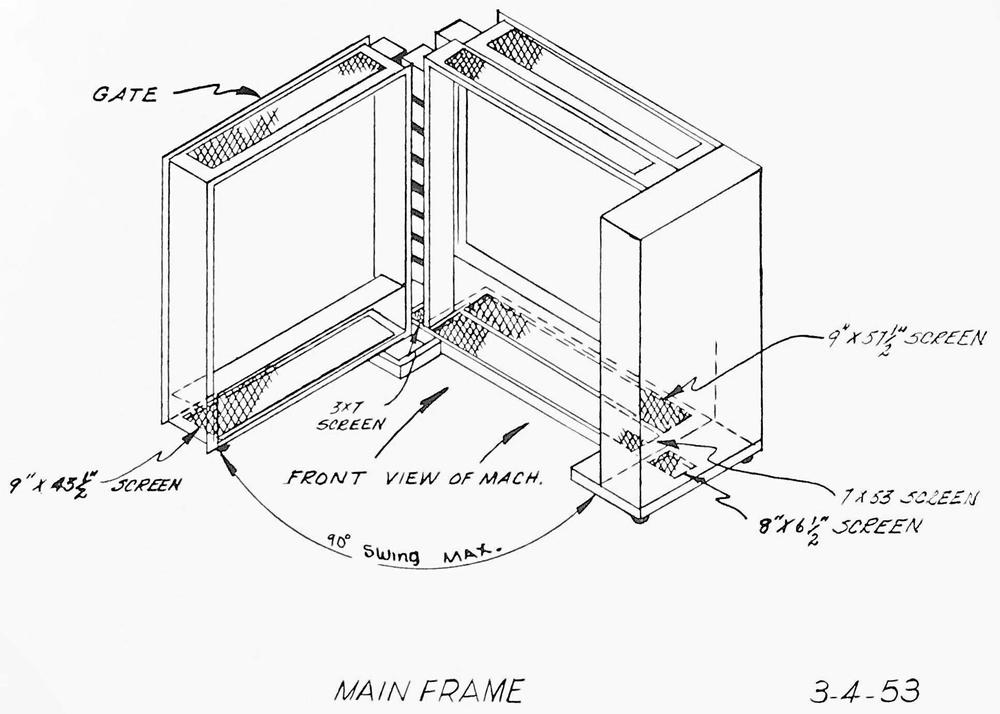
This diagram shows how the IBM 701 mainframe swings open for access to the circuitry. From “Type 701 EDPM [Electronic Data Processing Machine] Installation Manual”, IBM. From Computer History Museum archives.
The meaning of “mainframe” has evolved,
shifting from being a part of a computer to being a type of computer.
For decades, “mainframe” referred to the physical box of the computer;
unlike modern usage, this “mainframe” could be
a minicomputer or even microcomputer.
Simultaneously, “mainframe” was a synonym for “central processing unit.”
In the 1970s, the modern meaning started to develop—a large, powerful computer for transaction processing or business applications—but it took decades for this meaning to replace the earlier ones.
In this article, I’ll examine the history of these shifting meanings in detail.
Early computers and the origin of “main frame”
Early computers used a variety of mounting and packaging techniques including panels, cabinets, racks, and bays.3
This packaging made it very difficult to install or move a computer, often requiring cranes or the removal of walls.4
To avoid these problems, the designers of the IBM 701 computer came up with an innovative packaging technique.
This computer was
constructed as individual units that would pass through a standard doorway, would fit on a standard elevator,
and could be transported with normal trucking or aircraft facilities.7
These units were built from a metal frame with covers attached, so each unit was called a frame.
The frames were named according to their function, such as the power frames and the tape frame.
Naturally, the main part of the computer was called the main frame.
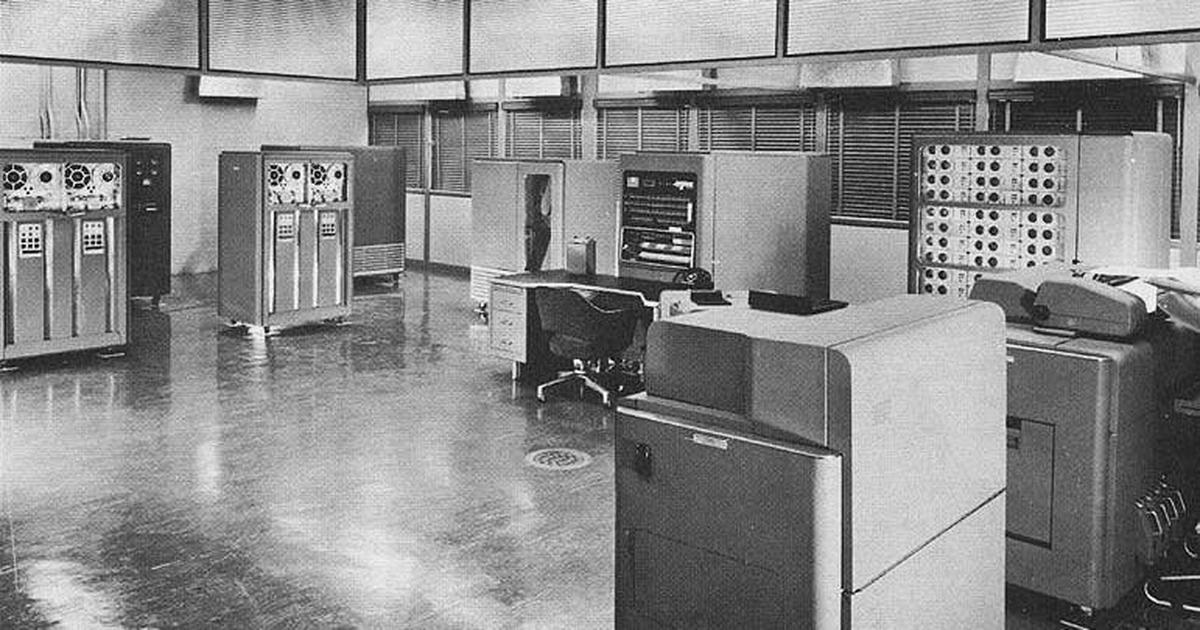
An IBM 701 system at General Motors. On the left: tape drives in front of power frames. Back: drum unit/frame, control panel and electronic analytical control unit (main frame), electrostatic storage unit/frame (with circular storage CRTs). Right: printer, card punch. Photo from BRL Report, thanks to Ed Thelen.
The IBM 701’s internal documentation used “main frame” frequently to indicate the main box of the computer, alongside
“power frame”, “core frame”, and so forth. For instance, each component in the schematics was labeled
with its location in the computer, “MF” for the main frame.6
Externally, however, IBM documentation described the parts of the 701 computer as units rather than frames.5
The term “main frame” was used by a few other computers in the 1950s.8
For instance, the JOHNNIAC Progress Report (August 8, 1952) mentions that “the main frame for the JOHNNIAC is ready to receive registers”
and they could test the arithmetic unit “in the JOHNNIAC main frame in October.”10
An article
on the RAND Computer in 1953 stated that
“The main frame is completed and partially wired”
The main body of a computer called ERMA is labeled “main frame” in
the 1955 Proceedings of the Eastern Computer Conference.9
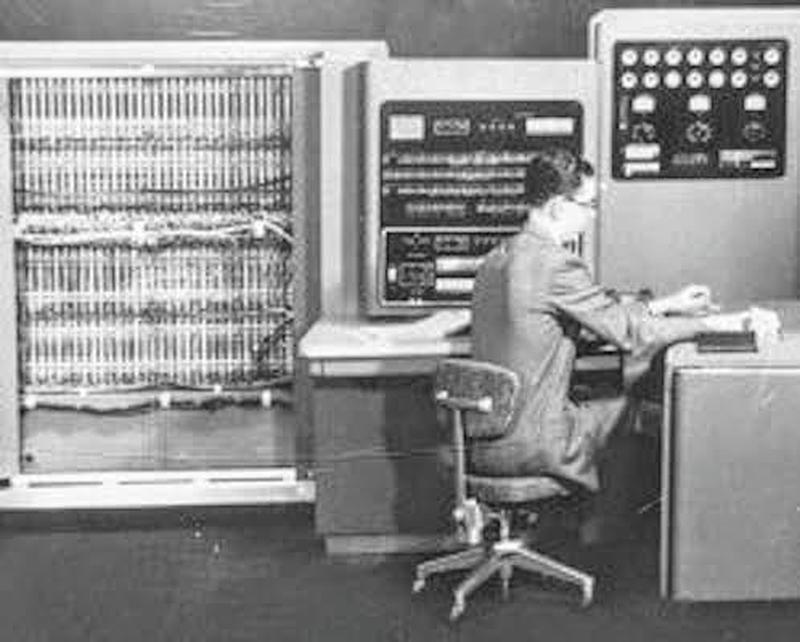
Operator at console of IBM 701. The main frame is on the left with the cover removed. The console is in the center. The power frame (with gauges) is on the right. Photo from NOAA.
The progression of the word “main frame” can be seen in reports from the Ballistics Research Lab (BRL) that list almost all the computers in the United States.
In the 1955 BRL report,
most computers were built from cabinets or racks;
the phrase “main frame” was only used with the IBM 650, 701, and 704.
By 1961, the BRL report shows “main frame” appearing in descriptions of the
IBM 702, 705, 709, and 650 RAMAC, as well as the Univac FILE 0, FILE I, RCA 501, READIX,
and Teleregister Telefile.
This shows that the use of “main frame” was increasing, but still mostly an IBM term.
The physical box of a minicomputer or microcomputer
In modern usage, mainframes are distinct from minicomputers or microcomputers.
But until the 1980s, the word “mainframe” could also mean the main physical part of a
minicomputer or microcomputer.
For instance, a “minicomputer mainframe” was not a powerful minicomputer, but simply the main part of a minicomputer.13
For example, the PDP-11 is an iconic minicomputer, but DEC ($0.00) discussed its “mainframe.”14.
Similarly, the desktop-sized HP 2115A and Varian Data 620i computers also had mainframes.15
As late as 1981, the book Mini and Microcomputers mentioned
“a minicomputer mainframe.”
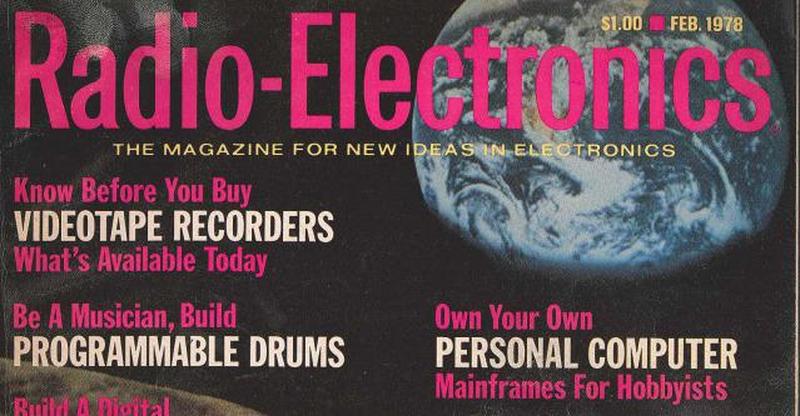
“Mainframes for Hobbyists” on the front cover of Radio-Electronics, Feb 1978.
Even microcomputers had a mainframe:
the cover of Radio Electronics (1978, above) stated,
“Own your own Personal Computer: Mainframes for Hobbyists”, using the definition below.
An article “Introduction to Personal Computers” in Radio Electronics (Mar 1979) uses a similar meaning:
“The first choice you will have to make is the mainframe or actual enclosure that the
computer will sit in.”
The popular hobbyist magazine BYTE also used “mainframe” to describe
a microprocessor’s box
in the 1970s and early 1980s16.
BYTE sometimes used
the word “mainframe” both to describe a large IBM computer and to describe a home computer box in the same issue, illustrating
that the two distinct meanings coexisted.
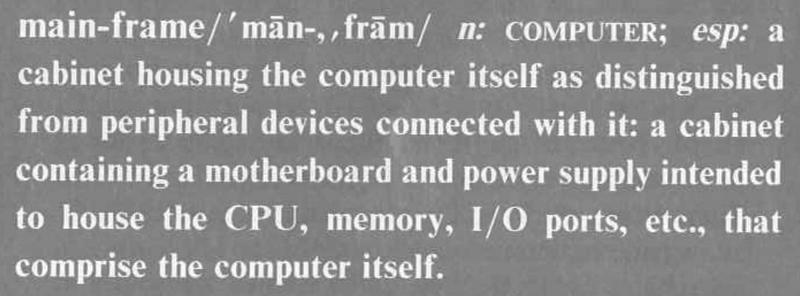
Definition from Radio-Electronics: main-frame n: COMPUTER; esp: a cabinet housing the computer itself as distinguished from peripheral devices connected with it: a cabinet containing a motherboard and power supply intended to house the CPU, memory, I/O ports, etc., that comprise the computer itself.
Main frame synonymous with CPU
Words often change meaning through metonymy, where a word takes on the meaning of something
closely associated with the original meaning.
Through this process, “main frame” shifted from the physical frame (as a box) to the functional contents of the frame,
specifically the central processing unit.17
The earliest instance that I could find of the “main frame” being equated with the central processing unit was in 1955.
Survey of Data Processors stated:
“The central processing unit is known by other names; the arithmetic and ligical [sic] unit, the main frame, the computer, etc. but we shall refer to it, usually, as the central processing unit.”
A similar definition appeared in Radio Electronics (June 1957, p37):
“These arithmetic operations are performed in what is called the arithmetic unit of the machine, also sometimes referred to as the ‘main frame.'”
The US Department of Agriculture’s
Glossary of ADP ($0.00) Terminology (1960) uses the definition:
“MAIN FRAME – The central processor of the computer system. It contains the main memory, arithmetic unit and special register groups.” I’ll mention that “special register groups” is nonsense that was repeated for years.18
This definition was reused and extended in the government’s Automatic Data Processing Glossary, published
in 1962 “for use as an authoritative reference by all officials and employees of the executive branch of the Government” (below). This definition was reused in many other places, notably the Oxford English Dictionary.19

Definition from Bureau of the Budget: frame, main, (1) the central processor of the computer system. It contains the main storage, arithmetic unit and special register groups. Synonymous with (CPU) and (central processing unit). (2) All that portion of a computer exclusive of the input, output, peripheral and in some instances, storage units.
By the early 1980s, defining a mainframe as the CPU had become obsolete. IBM stated that “mainframe” was a deprecated term for “processing unit” in
the Vocabulary for Data Processing, Telecommunications, and Office Systems (1981); the American National Dictionary for Information Processing Systems (1982) was similar.
Computers and Business Information Processing (1983)
bluntly stated:
“According to the official definition, ‘mainframe’ and ‘CPU’ are synonyms. Nobody uses the word mainframe that way.”
Guide for auditing automatic data processing systems (1961).](mainframe-diagram.jpg “w400”)
1967: I/O devices transferring data “independent of the main frame” Datamation, Volume 13.
Discusses other sorts of off-line I/O.
1967 Office Equipment & Methods: “By putting your data on magnetic tape and feeding it to your computer in this pre-formatted fashion, you increase your data input rate so dramatically that you may effect main frame time savings as high as 50%.”
Same in Data Processing Magazine, 1966
Equating the mainframe and the CPU led to a semantic conflict in the 1970s,
when the CPU became a microprocessor chip rather than a large box.
For the most part, this was resolved by breaking apart the definitions of “mainframe” and “CPU”, with the mainframe being the computer
or class of computers, while the CPU became the processor chip.
However, some non-American usages resolved the conflict by using “CPU” to refer to the box/case/tower of a PC.
(See discussion [here](https://news.ycombinator.com/item?id=21336515) and [here](https://superuser.com/questions/1198006/is-it-correct-to-say-that-main-memory-ram-is-a-part-of-cpu).)
–>
Mainframe vs. peripherals
Rather than defining the mainframe as the CPU, some dictionaries defined the mainframe in opposition to
the “peripherals”, the computer’s I/O devices.
The two definitions are essentially the same, but have a different focus.20
One example is the
IFIP-ICC Vocabulary of Information Processing (1966) which defined “central processor” and “main frame” as “that part of an automatic data processing system which is not considered as peripheral
equipment.”
Computer Dictionary (1982) had the definition
“main frame—The fundamental portion of a computer, i.e. the portion that contains the CPU and control elements of a computer system, as contrasted
with peripheral or remote devices usually of an input-output or memory nature.”
One reason for this definition was that computer usage was billed for mainframe time, while other tasks such as printing results could save money by
taking place directly on the peripherals without using the mainframe itself.21
A second reason was that the mainframe vs. peripheral split mirrored the composition of the computer industry, especially in the late 1960s and 1970s.
Computer systems were built by a handful of companies, led by IBM.
Compatible I/O devices and memory were built by many other companies that could sell them at a lower cost than IBM.22
Publications about the computer industry needed convenient terms to describe these two industry sectors, and they often used
“mainframe manufacturers” and “peripheral manufacturers.”
Main Frame or Mainframe?
An interesting linguistic shift is from “main frame” as two independent words to a compound word: either hyphenated “main-frame” or the single word “mainframe.”
This indicates the change from “main frame” being a type of frame to “mainframe” being a new concept.
The earliest instance of hyphenated “main-frame” that I found was from 1959 in IBM Information Retrieval Systems Conference.
“Mainframe” as a single, non-hyphenated word appears the same year in Datamation,
mentioning the mainframe of the NEAC2201 computer.
In 1962, the IBM 7090 Installation Instructions refer to a “Mainframe Diag[nostic] and Reliability Program.” (Curiously, the document also uses “main frame” as two words in several places.)
The 1962 book Information Retrieval Management discusses how much computer time document queries can take:
“A run of 100 or more machine questions may require two to five minutes of mainframe time.”
This shows that by 1962, “main frame” had semantically shifted to a new word, “mainframe.”
The rise of the minicomputer and how the “mainframe” become a class of computers
So far, I’ve shown how “mainframe” started as a physical frame in the computer, and then was generalized to describe
the CPU. But how did “mainframe” change from being part of a computer
to being a class of computers?
This was a gradual process, largely happening in the mid-1970s as the rise of the minicomputer and microcomputer created a need
for a word to describe large computers.
Although microcomputers, minicomputers, and mainframes are now viewed as distinct categories, this was not the case at first.
For instance, a 1966 computer buyer’s guide
lumps together computers ranging from desk-sized to 70,000 square feet.23
Around 1968, however, the term “minicomputer” was created to describe small computers.
The story is that the head of DEC in England created the term, inspired by the miniskirt and the Mini Minor car.24
While minicomputers had a specific name, larger computers did not.25
Gradually in the 1970s “mainframe” came to be a separate category, distinct from “minicomputer.”2627
An early example is Datamation (1970), describing systems of various sizes: “mainframe, minicomputer, data logger, converters, readers and sorters, terminals.”
The influential business report EDP first split mainframes from minicomputers in 1972.28
The line between minicomputers and mainframes was controversial, with articles such as
Distinction Helpful for Minis, Mainframes and
Micro, Mini, or Mainframe? Confusion persists (1981) attempting
to clarify the issue.29
With the development of the microprocessor, computers became categorized as mainframes, minicomputers or microcomputers.
For instance, a 1975 Computerworld article discussed how the minicomputer competes against the microcomputer and mainframes.
Adam Osborne’s An Introduction to Microcomputers (1977) described computers as divided into mainframes, minicomputers, and microcomputers by price, power, and size.
He pointed out the large overlap between categories and avoided specific definitions, stating that “A minicomputer is a minicomputer, and a mainframe is a mainframe, because that is what the manufacturer calls it.”32
In the late 1980s, computer industry dictionaries started defining a mainframe as a large computer, often explicitly contrasted with a
minicomputer or microcomputer. By 1990, they mentioned the networked aspects of mainframes.33
IBM embraces the mainframe label
Even though IBM is almost synonymous with “mainframe” now,
IBM avoided marketing use of the word for many years, preferring terms such as “general-purpose computer.”35
IBM’s book Planning a Computer System (1962) repeatedly referred to “general-purpose computers”
and “large-scale computers”, but never used the word “mainframe.”34
The announcement of the revolutionary System/360 (1964) didn’t use the word “mainframe”;
it was called a general-purpose computer system.
The announcement of the System/370 (1970) discussed
“medium- and large-scale systems.”
The
System/32 introduction (1977) said,
“System/32 is a general purpose computer…”
The 1982 announcement of the 3804, IBM’s most powerful computer at the time,
called it a “large scale processor” not a mainframe.
IBM started using “mainframe” as a marketing term in the mid-1980s.
For example, the 3270 PC Guide (1986)
refers to “IBM mainframe computers.”
An IBM 9370 Information System brochure (c. 1986) says the system was “designed to provide mainframe power.”
IBM’s brochure for the 3090 processor (1987) called them “advanced general-purpose computers” but also mentioned “mainframe computers.”
A System 390 brochure (c. 1990) discussed “entry into the mainframe class.”
The 1990 announcement
of the ES/9000 called them “the most powerful mainframe systems the company has ever offered.”
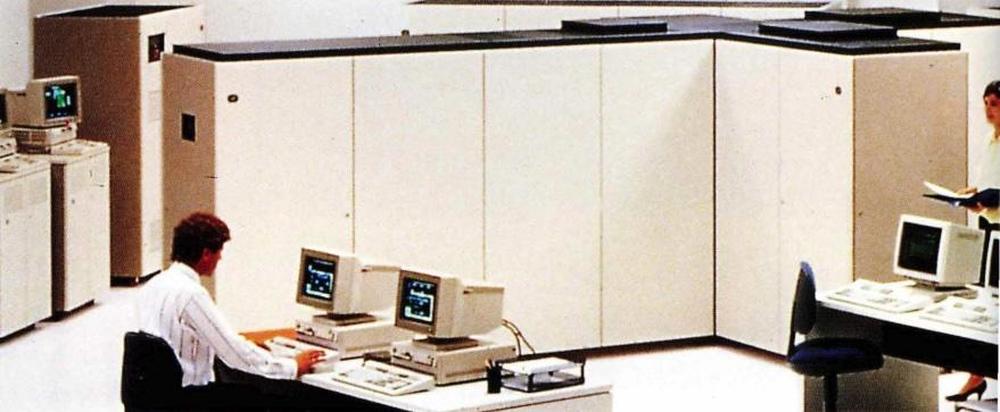
The IBM System/390: “The excellent balance between price and performance makes entry into the mainframe class an attractive proposition.” IBM System/390 Brochure
By 2000, IBM had enthusiastically adopted the mainframe label: the z900 announcement
used the word “mainframe” six times, calling it the “reinvented mainframe.”
In 2003, IBM announced “The Mainframe Charter”, describing IBM’s “mainframe values” and “mainframe strategy.”
Now, IBM has retroactively applied the name “mainframe” to their large computers going back to 1959 (link),
(link).
Mainframes and the general public
While “mainframe” was a relatively obscure computer term for many years, it became widespread in the 1980s.
The Google Ngram graph below shows the popularity of “microcomputer”, “minicomputer”, and “mainframe” in books.36
The terms became popular during the late 1970s and 1980s.
The popularity of “minicomputer” and “microcomputer” roughly mirrored the development of these classes of computers.
Unexpectedly, even though mainframes were the earliest computers, the term “mainframe” peaked later than the
other types of computers.
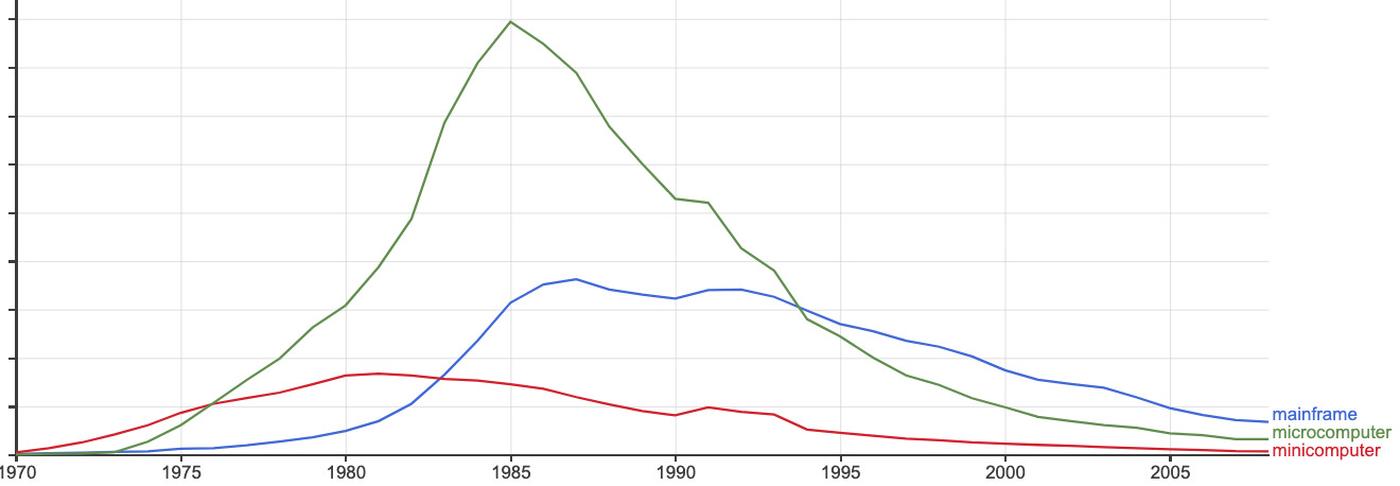
N-gram graph from Google Books Ngram Viewer.
Dictionary definitions
I studied many old dictionaries to see when the word “mainframe” showed up and how they defined it.
To summarize, “mainframe” started to appear in dictionaries in the late 1970s, first defining the mainframe in opposition to peripherals or as the CPU.
In the 1980s, the definition gradually changed to the modern definition, with a mainframe distinguished as being large, fast, and often centralized system.
These definitions were roughly a decade behind industry usage, which switched to the modern meaning in the 1970s.
The word didn’t appear in older dictionaries, such as the Random House College Dictionary (1968) and Merriam-Webster (1974).
The earliest definition I could find was in the supplement to Webster’s International Dictionary (1976):
“a computer and esp. the computer itself and its cabinet as distinguished from peripheral devices connected with it.”
Similar definitions appeared in Webster’s New Collegiate Dictionary
(1976,
1980).
A CPU-based definition appeared in
Random House College Dictionary (1980): “the device within a computer which contains the central control and arithmetic units, responsible for the essential control and computational functions. Also called central processing unit.”
The Random House Dictionary (1978, 1988 printing) was similar.
The American Heritage Dictionary (1982,
1985) combined the CPU and peripheral approaches: “mainframe. The central processing unit of a computer exclusive of peripheral and remote devices.”
The modern definition as a large computer appeared alongside the old definition in Webster’s Ninth New Collegiate Dictionary (1983): “mainframe (1964): a computer with its cabinet and internal circuits; also: a large fast computer that can handle multiple tasks concurrently.”
Only the modern definition appears in The New Merriram-Webster Dictionary (1989): “large fast computer”,
while
Webster’s Unabridged Dictionary of the English Language (1989): “mainframe. a large high-speed computer with greater storage capacity than a minicomputer, often serving as the central unit in a system of smaller computers. [MAIN + FRAME].”
Random House Webster’s College Dictionary (1991)
and
Random House College Dictionary (2001) had similar definitions.
The Oxford English Dictionary is the principal historical dictionary, so it is interesting to see its view.
The 1989 OED gave historical definitions as well as defining mainframe as “any large or general-purpose computer, exp. one supporting numerous peripherals or
subordinate computers.”
It has seven historical examples from 1964 to 1984; the earliest is
the 1964 Honeywell Glossary.
It quotes a 1970 Dictionary of Computers as saying that the word “Originally implied the main framework of a central processing unit on which the arithmetic
unit and associated logic circuits were mounted, but now used colloquially to refer to the central processor itself.”
The OED also cited a Hewlett-Packard ad from 1974 that used the word “mainframe”, but I consider this a mistake
as the usage is completely different.15
Encyclopedias
A look at encyclopedias shows that the word “mainframe” started appearing in discussions of computers in the early 1980s,
later than in dictionaries.
At the beginning of the 1980s, many encyclopedias focused on large computers, without using the word “mainframe”, for instance, The Concise Encyclopedia of the Sciences (1980)
and World Book (1980).
The word “mainframe” started to appear in supplements such as
Britannica Book of the Year (1980) and
World Book Year Book (1981), at the same time as they started discussing microcomputers.
Soon encyclopedias were using the word “mainframe”, for example,
Funk & Wagnalls Encyclopedia (1983),
Encyclopedia Americana (1983),
and World Book (1984).
By 1986, even the Doubleday Children’s Almanac showed a “mainframe computer.”
Newspapers
I examined old newspapers to track the usage of the word “mainframe.”
The graph below shows the usage of “mainframe” in newspapers. The curve shows a rise in popularity through the 1980s and a steep drop in the late 1990s.
The newspaper graph roughly matches the book graph above, although newspapers show a much steeper drop in the late
1990s. Perhaps mainframes aren’t in the news anymore, but people still write books about them.

Newspaper usage of “mainframe.” Graph from newspapers.com from 1975 to 2010 shows usage started growing in 1978, picked up in 1984, and peaked in 1989 and 1997, with a large drop in 2001 and after (y2k?).
The first newspaper appearances were in classified ads seeking employees, for instance, a
1960 ad in the San Francisco Examiner for people “to monitor and control main-frame operations of electronic computers…and to operate peripheral equipment…” and
a (sexist) 1966 ad in the Philadelphia Inquirer for “men with Digital Computer Bkgrnd [sic] (Peripheral or Mainframe).”37
By 1970, “mainframe” started to appear in news articles, for example,
“The computer can’t work without the mainframe unit.”
By 1971, the usage increased with phrases such as “mainframe central processor” and “‘main-frame’ computer manufacturers”.
1972 had usages such as “the mainframe or central processing unit is the heart of any computer, and does all the calculations”.
A 1975 article explained
“‘Mainframe’ is the industry’s word for the computer itself, as opposed to associated items such as printers, which are referred to as ‘peripherals.'”
By 1980, minicomputers and microcomputers were appearing:
“All hardware categories-mainframes, minicomputers, microcomputers, and terminals” and
“The mainframe and the minis are interconnected.”
By 1985, the mainframe was a type of computer, not just the CPU:
“These days it’s tough to even define ‘mainframe’. One definition is that it has for its electronic brain
a central processor unit (CPU) that can handle at least 32 bits of information at once.
… A better distinction is that mainframes have numerous processors so they can work on several jobs at once.”
Articles also discussed
“the micro’s challenge to the mainframe” and
asked, “buy a mainframe, rather than a mini?”
By 1990, descriptions of mainframes became florid: “huge machines laboring away in glass-walled rooms”, “the big burner which carries the whole computing load for an organization”,
“behemoth data crunchers”,
“the room-size machines that dominated computing until the 1980s”,
“the giant workhorses that form the nucleus of many data-processing centers”,
“But it is not raw central-processing-power that makes a mainframe a mainframe. Mainframe computers command their much higher prices because they have much more sophisticated input/output systems.”
Conclusion
After extensive searches through archival documents, I found usages of the term “main frame” dating back to 1952, much earlier than previously reported.
In particular, the introduction of frames to package the IBM 701 computer led to the use of the word “main frame” for
that computer and later ones.
The term went through various shades of meaning and remained fairly obscure for many years. In the mid-1970s,
the term started describing a large computer, essentially its modern meaning.
In the 1980s, the term escaped the computer industry and appeared in dictionaries, encyclopedias, and newspapers.
After peaking in the 1990s, the term declined in usage (tracking the decline in mainframe computers), but the term and the mainframe computer both survive.
Two factors drove the popularity of the word “mainframe” in the 1980s with
its current meaning of a large computer.
First, the terms “microcomputer” and “minicomputer” led to linguistic pressure for a parallel term for large computers.
For instance, the business press needed a word to describe IBM and other large computer manufacturers.
While “server” is the modern term, “mainframe” easily filled the role back then and was nicely alliterative with “microcomputer” and “minicomputer.”38
Second, up until the 1980s, the prototype meaning for “computer” was a large mainframe, typically IBM.39
But as millions of home computers were sold in the early 1980s, the prototypical “computer” shifted to smaller machines.
This left a need for a term for large computers, and “mainframe” filled that need.
In other words, if you were talking about a large computer in the 1970s, you could say “computer” and people would assume you meant a mainframe.
But if you said “computer” in the 1980s, you needed to clarify if it was a large computer.
The word “mainframe” is almost 75 years old and both the computer and the word have gone through extensive
changes in this time. The “death of the mainframe” has been proclaimed for well over 30 years but mainframes are still hanging on.
Who knows what meaning “mainframe” will have in another 75 years?
Follow me on Bluesky (@righto.com) or
RSS. (I’m no longer on Twitter.)
Thanks to the Computer History Museum and archivist Sara Lott for access to many documents.
Notes and References







